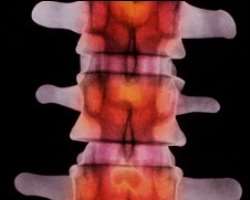Risk-free virtual anaesthetics

Medical staff can learn the delicate procedure of spinal anaesthesia without practising on live patients, thanks to a new training device.
It uses computer graphics and a virtual needle to realistically recreate contact with the spine.
The tool was developed by scientists at the University of Limerick, Ireland.
In the past, the procedure was fraught with danger, and medical staff learning the technique had to take extreme care not to damage patients' spinal columns.
According to the scientists, this is a major breakthrough in the process of teaching spinal anaesthesia, and could be used widely in hospitals within three years.
Recreating surgery
Human vertebrae are protected by a delicate gel like substance that is less than one inch thick.
Safely injecting the spine is very difficult; anaesthetists run the risk of damaging a patient's spinal column or the blood vessels that serve it.
Developed in conjunction with Dr George Shorten of Cork University Hospital, the new simulator exploits state of the art 'haptic toolkits'.
These are multi-disciplinary technologies that can accurately recreate the touch and feel of real-time surgery.
Dr Mikael Fernstrom, head of Limerick University's masters degree in interactive media, says the project has tremendous potential.
The advance comes at a time of growing concern over patient safety, and new EU legislation limiting working hours in hospitals.
In addition, some patients cannot be completely anaesthetised during spinal procedures, for fear of post-operative complications.
Such problems make the use of surgical simulators all the more vital.
Erik Lovquist, a researcher with Limerick's Interaction Design Centre (IDC), concurs: "Many means of assessing doctors and surgeons in training environments has, in the past, been subjective.
"This tool offers trainers a chance to objectively test students in the field."
'Feedback'
The "haptic simulator" recreates the skin tension felt by the practitioner at the point the needle is inserted.
If the injection is not carried out correctly, the trainee receives immediate audio and visual feedback.
The developers questioned doctors extensively about the precise tactile responses involved in inserting a needle between two vertebrae of the human back.
The result is an advance that incorporates visual feedback - allowing the operator to view a 3-D map of the area while simultaneously positioning the needle.
SPINAL ANAESTHESIA
Trainees can operate in either "trial" or "practise" mode, and safely locate the optimal point for a spinal injection - called the "intrathecal space".
In trial mode, the audio and visual clues can be turned off.
Correct placement of the needle is registered by the sight of fluid draining from the needle, which is what happens during the real procedure.
This could be used to train surgeons to carry out operations on elderly people, epidurals on expectant mothers and lumbar punctures to obtain biopsy samples of the cerebro-spinal fluid (CSF) that circulates around the spinal cord.
Currently, the IDC team led by Professor Liam Bannon are half way through the development phase and have embarked on trials in Hungary and Ireland.
